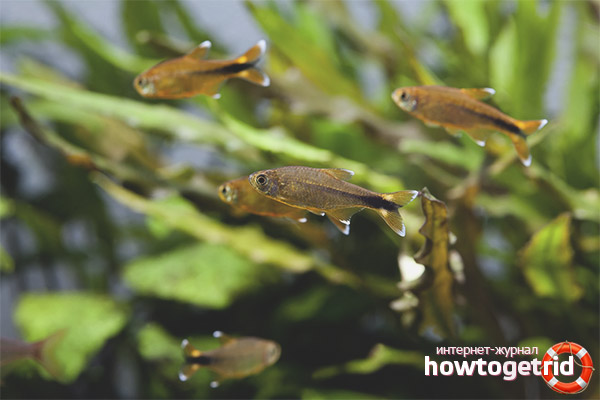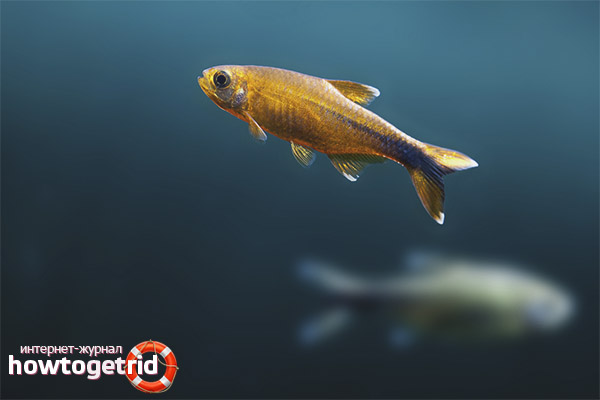The content of the article
Copper tetra or Hassemania is a common example of aquarium fish due to its moderate care and maintenance requirements. She has been actively bred at home for over six decades, especially appreciating the copper color of males with delicate porcelain fins.
It is also known that males are not only more attractive, but also slim. Females begin to actively get fat during spawning, and the body is covered with yellowish scales. In its usual state, the latter has a pleasant monochrome olive tint. Also along the body of the fish stretches a noticeable silver strip. On average, an individual has an elongated body that resembles a rhombus in shape.
Many aquarists appreciate the copper Tetra for its attractive color, but it often loses its beauty, dies in captivity and does not breed. That is why it is very important to observe the conditions of its maintenance and care, which will help extend the life of pets up to 4 years.
How to keep Hasemania in the aquarium
Representatives of this species like space, so it will be optimal to purchase an elongated and roomy aquarium.
The body length of each fish is 40-60 cm, but in nature you can also find 150 mm of "giants". Fish should be kept in schools (at least 8 specimens), which will allow them to behave naturally and naturally in captivity. Loneliness is contraindicated for Tetra - she will quickly wither, lose her playfulness. Also, when solitary or paired, these fish can begin to dominate the representatives of the aquarium (for example, bite the fins of other fish).
Under optimal conditions, the Khasemaniy flock normally adjoins other small peaceful fish (Guppies, Swordsmen, Konko, Mollinesia and others). Tetra poorly tolerates neighborhood with gold fish and carps, astronotuses, cichlids. Optimum neighbors consider Ternetia, other types of Tetra, Rodostomus.
Pick up the soil for the aquarium in dark shades (sand), which is preferable for copper Tetra. And to create a natural environment, put a few snags at the bottom. As for the vegetation, the fish are unpretentious and do not spoil the environment. Experienced aquarists advise placing thickets of living plants (limnophile, kabomba, alternanterra), as well as floating ones (pistachia, richia, azzola, etc.). It is acceptable to use decor (stones, roots, caves), but remember that the fish is mobile and requires enough space for swimming.
As a rule, the flock mainly floats in the middle and upper layer of the liquid; it is distinguished by its energy and mobility. In rare cases, fish can jump out of the aquarium, so it would be advisable to cover it with a lid on top. By the way, representatives of the species are quite demanding on the characteristics of water. A suitable temperature of the content is considered to be 24-26 ° C, the acidity is not more than 7.5 points, and the hardness is up to 20 degrees. To create specific conditions allow special chemicals for the aquarium, which can be purchased at an affordable price in a pet store. As for water purification, it is necessary to replace 30% of the aquarium fluid weekly, since copper Tetra need purified water.
An important requirement for keeping Hasemania in captivity is the installation of a filter to purify water and enrich it with oxygen.
In poor living conditions, fish lose their natural mobility and activity, turn pale.
Feeding Features
Feeding fish of this species is not burdensome, as they are not picky.For the preparation of a normal diet, a nauplius of brine shrimp, coronetra, tubule, cyclops, daphnia, bloodworms and similar organisms (in live and frozen form) is quite suitable. The listed feeds (except the tubule maker) maintain the brightness of the pet's color. Overeating with a bloodworm leads to disorders of the intestines of the fish, since the latter is poorly absorbed. Overeating by the tubulator quickly causes obesity.
Tetra does not particularly like plant food, which is why these fish are not a threat to the small-leaved flora placed in the aquarium.
In some cases, specialized and high-quality dry food is acceptable, but against the background of such feeding, dullness of the scales can be observed. In feeding the Tetra moderation and variety are important. Overfished fish die quickly.
How to breed a copper tetra

It is believed that the reproduction of these fish is quite simple, but to obtain a sufficient number of young animals, it is advisable for the aquarist to purchase a spawning - a special aquarium of about 50 liters (a small flock). It is important to maintain a balance of males and females (one to one).
12 days before the alleged start of spawning, producers are placed in spawning and actively feed with a variety of feeds (there must be living organisms in the diet).
For optimal fertilization, it is necessary to maintain water parameters: the temperature is slightly higher than usual (25-27 ° C), reduced acidity (up to 6.5 points), reduced hardness (up to 8 degrees). The water level should be about 200 mm.
At the bottom of the spawning aquarist places a special grid for spawning, which will allow caviar to settle in it, preventing producers from eating. Also on the bottom you can put Javanese moss and cinnamon.
The first larvae hatch after 1-2 days, and after 3-4 days, fry develop. The latter are very sensitive to light. For them, an infusoria, brine shrimp or rotifers may serve as the initial food. A good effect on the formation and development of young copper Tetra is the daily replacement of water (20% of all liquid). But to begin a water change is necessary only after the fry can feed themselves.
It should be borne in mind that males reach puberty by about six months of life, and females are ready to spawn by the age of 4 months.
In general, copper Tetra is an attractive, playful and peace-loving fish that has not gone out of fashion with aquarists for decades. It is demanding in the neighborhood with other fish and quickly loses its bright color with improper care. But still it gives a lot of pleasant emotions to the owner of the aquarium and enviable offspring.
Video: aquarium fish copper tetra










Submit